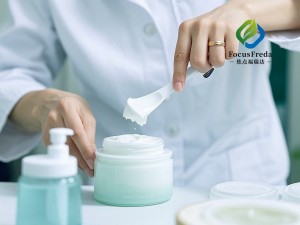How To Use Hyaluronic Acid Raw Materials For Personal Formulators: Basic Formulation Guide
This is a comprehensive guide to help personal formulators use hyaluronic acid (HA) raw materials scientifically, from basic knowledge to advanced formulation techniques.
1. Core Characteristics of Hyaluronic Acid
Hyaluronic acid is a biopolysaccharide that exists naturally in the skin and connective tissue. It is known for its excellent moisturizing ability and biocompatibility. It can absorb 1000 times its own weight of water from the air to form a water molecule network. Depending on the molecular weight of HA, its efficacy in skin care products is also different:
- High molecular weight (>1000 kDa): Forms a water-locking film on the surface of the skin to reduce water loss. It is suitable for long-lasting moisturizing products such as creams and masks.
- Medium molecular weight (100–1000 kDa): Enhances skin elasticity and optimizes barrier function. It is suitable for essences and gel skin care products.
- Low molecular weight (<10 kDa): Has stronger permeability and can penetrate deep into the skin to provide deep nourishment and repair. It is suitable for repair essences and anti-aging products.
- Oligomeric hyaluronic acid (≤800 Da): With its extremely small molecular structure, it is easier to penetrate into the dermis and stimulate the natural synthesis of hyaluronic acid and collagen, making it an ideal choice for high-efficiency anti-aging formulas.
When selecting hyaluronic acid raw materials, the actual product functional requirements should be considered. For example, if a personal formulator wants to make a deep hydrating serum, he can use a combination of low-molecular and medium-molecular hyaluronic acid, while a water-locking barrier cream is suitable for high-molecular hyaluronic acid.
2. Preparation before Formulating
Hyaluronic acid is highly hygroscopic, and improper operation may cause contamination or decreased stability. Before making a formula, the following points should be ensured:
· Clean and sterile environment: Use sterilized tools such as stirring rods and measuring cups, and operate in an environment with low humidity.
· Add in batches: Avoid adding too much hyaluronic acid at one time to reduce agglomeration.
· Temperature control: The water temperature for dissolving hyaluronic acid should be kept between room temperature and 30°C to avoid degradation caused by overheating.
3. Recommended Method for Adding Hyaluronic Acid
(1) Dissolving hyaluronic acid
Hyaluronic acid is easily soluble in water but not in alcohol. It should be dissolved in the water phase of the formula. The specific steps are as follows:
Slowly sprinkle the required amount of hyaluronic acid into warm water and stir continuously to prevent the formation of clumps.
Let it stand for 15-30 minutes to fully hydrate and form a uniform solution.
Stir gently until it is completely dissolved and there are no visible particles.
Typical concentration recommendations:
Essence: 0.1% – 1%
Lotion/cream: 0.1% – 0.5%
Highly moisturizing gel: 1% – 2%
(2) Combine with other ingredients
Hyaluronic acid can be combined with a variety of other skin care ingredients to enhance product efficacy:
Niacinamide: synergistically brightens skin tone and repairs skin barrier.
Panthenol: Soothing and repairing, suitable for specific sensitive skin care products.
Ceramide: Improves water retention ability and forms a synergistic moisturizing effect with HA.
Sodium polyglutamate: When used with HA, it can effectively prolong the action time of HA, reduce the stickiness of HA, and make the skin feel naturally smooth.
4. pH Control
Hyaluronic acid is stable in the pH range of 5-7, and excessive acidity or alkalinity may cause degradation. Methods for adjusting pH:
If the pH is low (<5), use sodium hydroxide (NaOH) to increase it appropriately.
If the pH is high (>7), add citric acid to reduce it to an appropriate range.
5. Storage and Shelf Life
The stability of the hyaluronic acid formula is affected by the storage environment. Please refer to the following suggestions:
Store in sealed containers: avoid oxidation and moisture absorption, and use light-shielding packaging.
Low temperature and light protection: Store at 4-10°C, away from heat sources and direct sunlight.
Regular testing: Pay attention to changes in formula viscosity. If the raw material thickens or clumps abnormally, it may indicate that the hyaluronic acid has degraded or is affected by moisture.
6. Summary
For individual formulators, hyaluronic acid is not only a powerful moisturizer, but also can achieve multi-dimensional skin care effects through precise selection of molecular weight. Focusfreda can provide global customers with sodium hyaluronate raw materials ranging from 400Da to 3MillionDa to meet diversified formulation needs and help develop high-performance skin care products.
Ingredients
Hyaluronic Acid & Tremella Fuciformis Polysaccharide
Collagen & Chondroitin Sulfate
Contact Us
 Address
Address
 Email
Email

© Copyright - 2010-2025 : All Rights Reserved. Hot Products - Sitemap
Food Grade Sodium Hyaluronate,
Sodium Hyaluronate Powder,
Food Grade Sodium Hyaluronate Powder,
Sodium Hyaluronate Structure,
Concentrated Sodium Hyaluronate,
Freda Sodium Hyaluronate Powder,









